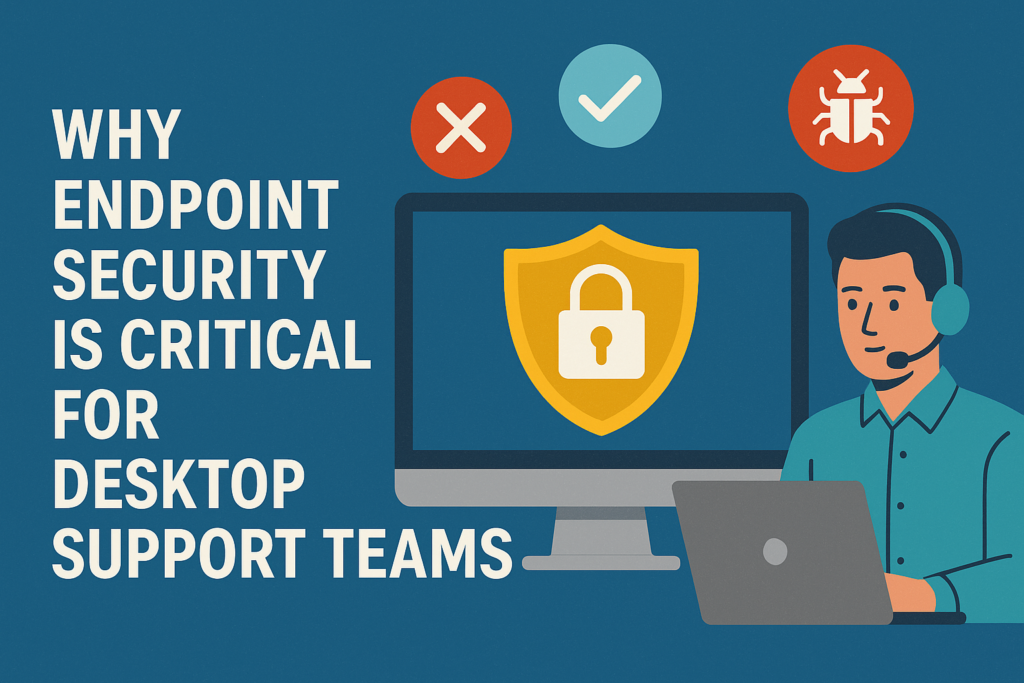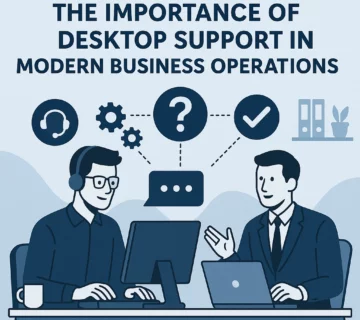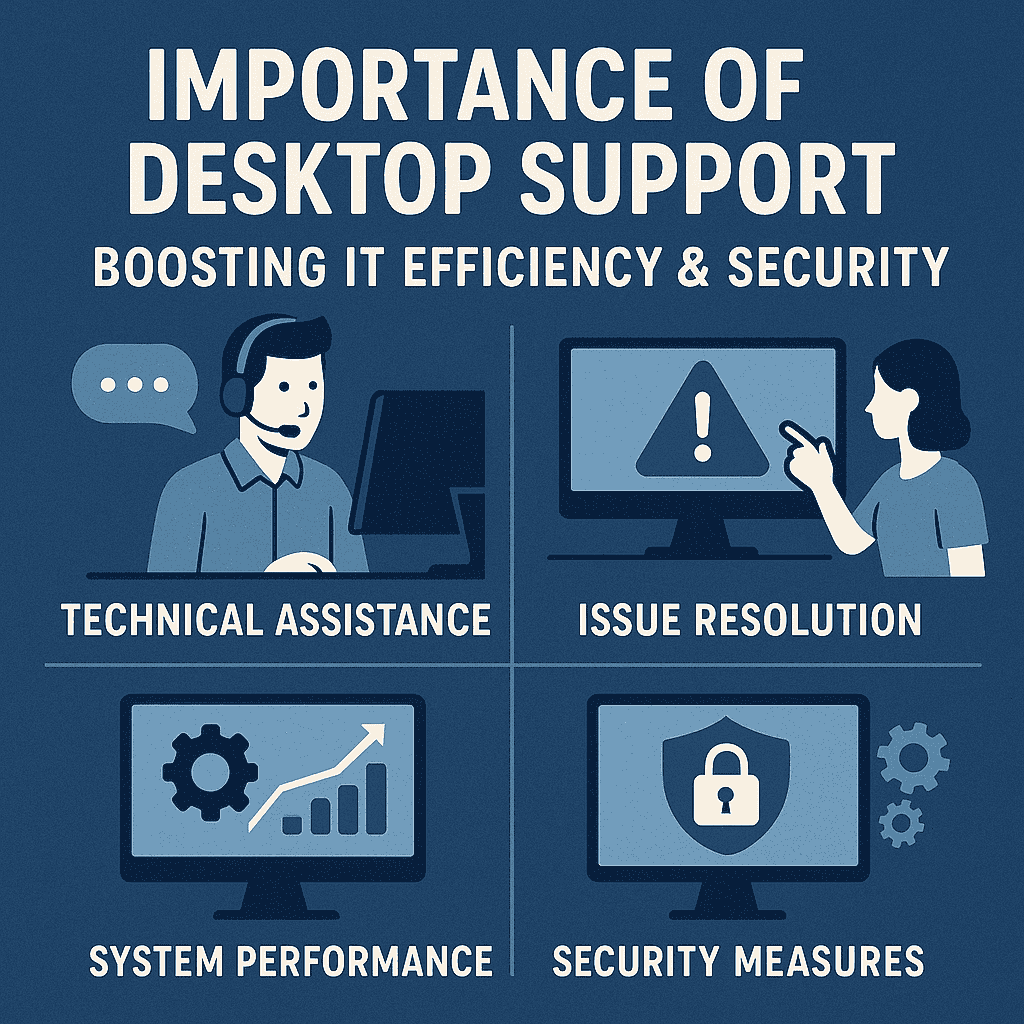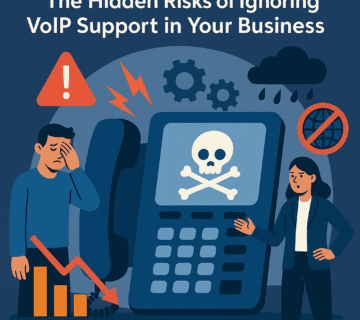Why Endpoint Security Is Critical for Desktop Support Teams

In an increasingly digital business world, endpoint security is a critical necessity — especially for desktop support teams tasked with safeguarding access to corporate systems. The significance of this responsibility only grows as businesses expand their digital infrastructure and adopt hybrid and remote work models.
Endpoint security isn’t just an IT concern; it’s a business survival issue. Cybercriminals view unprotected endpoints as soft targets, exploiting desktops and laptops to access networks, steal sensitive data, or unleash malware. For this reason, desktop support teams — those who configure, manage, and support end-user devices — are the first line of defense.
The Role of Desktop Support in Cybersecurity
Desktop support technicians have unique access and responsibilities. They install software, apply security patches, manage user permissions, and troubleshoot issues — activities that can expose systems to threats if not handled securely.
To navigate this evolving environment, professionals are now pursuing desktop support technician certification programs. These courses emphasize cybersecurity best practices, from secure configuration and malware detection to policy enforcement and system hardening.
Moreover, teams that incorporate proactive desktop support strategies — such as regular audits, remote monitoring, and automated updates — are far better equipped to neutralize threats before they materialize.
Understanding Endpoint Security for Desktop Teams
Endpoint security refers to a strategy of protecting network entry points — devices such as desktops, laptops, mobile phones — from malicious threats. It typically involves:
- Antivirus and anti-malware tools
- Firewalls and intrusion prevention systems
- Encryption mechanisms
- Remote monitoring and control
- Behavior-based threat detection (EDR)
When these tools are configured and monitored effectively by desktop support teams, they significantly reduce the chances of unauthorized access and data breaches.
The Cyber Threat Landscape for Desktop Environments
Desktops, often used for extended work, store a wealth of sensitive data and access critical networks. Threat actors understand this and increasingly target these systems using:
- Phishing emails
- Ransomware injections
- Zero-day exploits
- Unpatched software vulnerabilities
Without robust desktop support practices in place, these threats can spread quickly, leading to data loss, downtime, and financial damage.
Remote Work: A Security Challenge for Desktop Teams
The rise of remote and hybrid work introduces significant complexity. Remote employees may use unsecured Wi-Fi, outdated software, or personal devices that lack enterprise-level protection.
Here’s where Remote Desktop Support and cloud-based endpoint management become indispensable. Desktop teams must manage endpoints scattered across locations, ensuring:
- Regular updates and patching
- Enforced use of VPNs
- Multi-factor authentication
- Device encryption
- Remote lock or wipe capabilities
With cloud-based tools and desktop support hacks like automated policy enforcement, teams can secure remote endpoints as effectively as in-office machines.
Benefits of Proactive Desktop Support in Endpoint Security
Proactive strategies shift the focus from reactive firefighting to preemptive protection. Some proven methods include:
- Scheduled patching and system checks
- User activity monitoring
- Access controls and least privilege policies
- Phishing simulation and awareness training
Combining automation with vigilance creates a resilient environment that protects not only devices but also the users and the business as a whole.
Real-World Consequences of Weak Endpoint Security
Consider these high-profile breaches:
- WannaCry Ransomware (2017): Exploited a vulnerability in outdated Windows systems, affecting 200,000+ endpoints globally.
- Target (2013): Hackers accessed 40 million payment records through a compromised vendor endpoint.
- Colonial Pipeline (2021): Remote desktop protocol abuse caused fuel shortages across the U.S. East Coast.
These cases underline the essential role of secure, well-managed endpoints — the very domain of desktop support professionals.
Aligning Desktop Support with Compliance
Industries like healthcare, finance, and e-commerce face strict regulatory requirements:
- HIPAA in healthcare
- GDPR in Europe
- PCI-DSS for payment systems
Endpoint security tools help enforce compliance by ensuring:
- Access logs are maintained
- Unauthorized software is blocked
- Sensitive data is encrypted
- Devices can be remotely disabled
Through sound desktop support practices, organizations can maintain regulatory readiness and avoid hefty fines.
Building the Business Case for Endpoint Security
Investing in endpoint protection isn’t just a tech decision — it’s a business imperative. Consider these ROI factors:
- Reduced downtime from malware
- Minimized data breach costs
- Preserved customer trust
- Improved IT efficiency
Getting leadership buy-in is easier when desktop teams demonstrate how endpoint tools reduce ticket volumes, streamline operations, and protect revenue.
Best Tools and Technologies for Desktop Teams
To bolster security, desktop support teams should deploy:
- EDR (Endpoint Detection and Response) tools like CrowdStrike or SentinelOne
- Unified Endpoint Management (UEM) solutions like Microsoft Intune or ManageEngine
- Automation platforms for policy enforcement
- AI-based monitoring tools for anomaly detection
Integration with helpdesk systems ensures faster responses and richer context during troubleshooting.
FAQs
Why is endpoint security important in desktop support?
Endpoint security is essential because desktop systems are common entry points for cyberattacks. Securing them prevents breaches and ensures business continuity.
What certifications should desktop support technicians pursue?
Certifications like CompTIA A+, Microsoft MD-102, and Cisco’s IT Support certifications emphasize endpoint security fundamentals.
How does remote desktop support impact endpoint security?
It increases the attack surface, making it vital to use secure protocols, VPNs, and endpoint monitoring for remote access management.
Can proactive desktop support prevent breaches?
Absolutely. By applying updates, monitoring systems, and enforcing strict policies, teams can prevent most common attacks.
What are some desktop support hacks for better security?
Using automation scripts, remote wiping tools, policy templates, and smart user education modules are a few powerful hacks.
How does endpoint security support compliance?
It enforces data protection, logs access, restricts unauthorized use, and supports auditing for regulations like GDPR and HIPAA.
Conclusion
Endpoint security is the backbone of a strong cybersecurity strategy — and desktop support teams are its nerve center. From managing software to offering Remote Desktop Support, their role is pivotal in protecting enterprise environments.
By combining modern tools, smart tactics, and continuous training (like pursuing a desktop support technician certification), teams can outpace threats, secure user endpoints, and champion a culture of proactive security.
The organizations that recognize and empower their desktop support teams will always stay a step ahead.




No comment